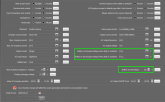Venezuela Solar
New Member
- Joined
- Dec 6, 2019
- Messages
- 146
Recently i did some testing on my battery bank to confirm AH capacity, i have an LV2424 and 4 100AH renogy gel batteries, 2Sx2P, i set it to a maximum D.O.D of 24v, it wont let me set any voltage over 24v, i want it to be 24.6 but it wont let me, any way, i tested it with 300w average continuos load, and i checked from time to time to confirm the voltage, after an hour, the voltage was 25.1v, but the it shows code 04, in the manual says it means low battery, but i dont think is low, extra info i turn on the pump for a moment to see how the voltage drops, after this is when code 04 appeared, my theory is that voltage went down and then up again, i could not see at the moment because the pump and the inverter are in different places. My pump takes the inverter to 1.5kw on peak after that goes to 1kw continuos load for a minute and then it turns off, do you think there is some wrong with my bank? The batteries havent really be cycled even once, they brand new




